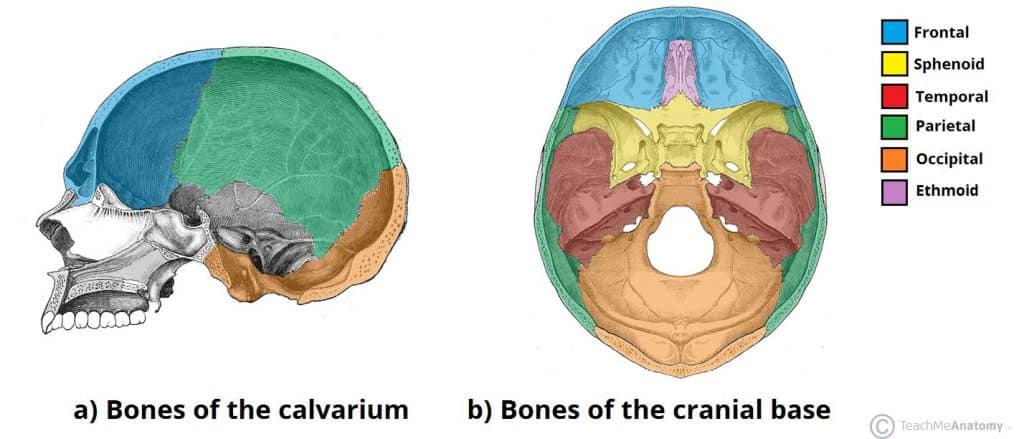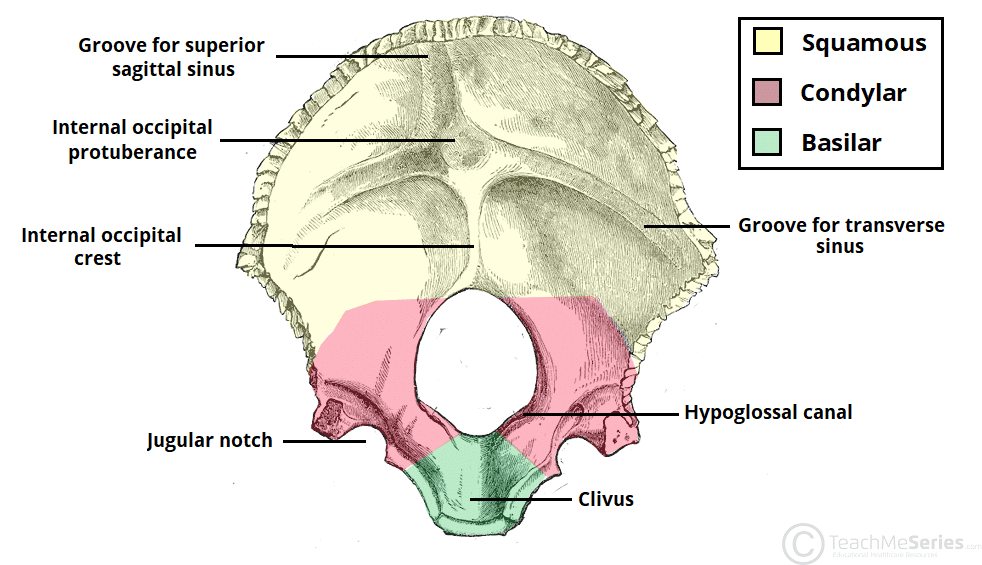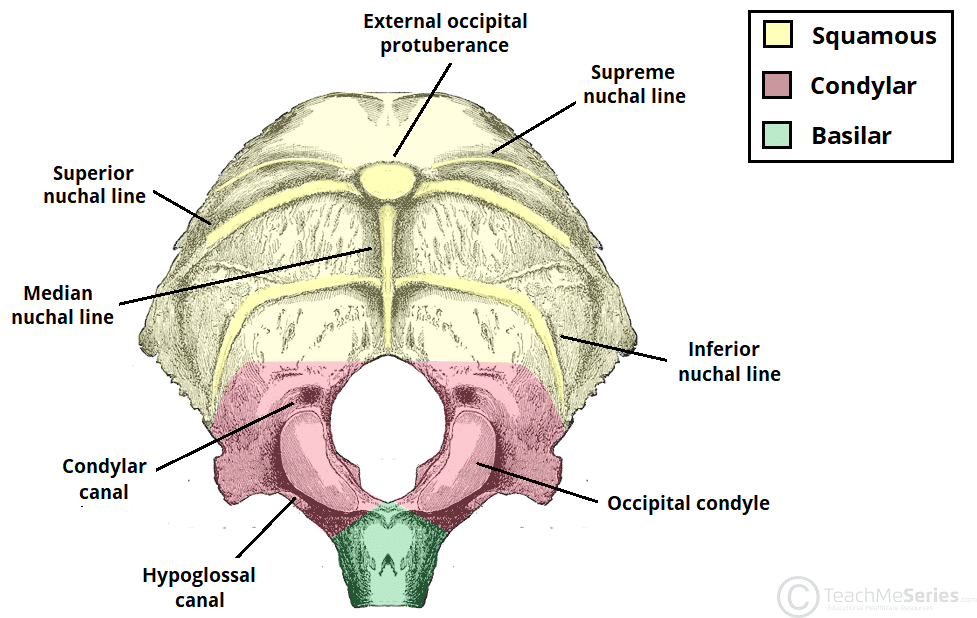The occipital bone is a flat, unpaired bone that forms a major part of the posterior wall and base of the skull.
It is a complex structure that protects the cerebellum and occipital lobes of the cerebrum and provides attachment to several muscles and ligaments.
In this article, we shall look at the anatomy of the occipital bone – its component parts, articulations, and clinical correlations.
Anatomical Structure
The occipital bone curves on itself and is trapezoid in shape. It contains outer and inner layers of cortical bone, with cancellous bone sandwiched between them.
There are three parts to the occipital bone – squamous, condylar, and basilar. We shall now review each part in more detail.
Squamous
The squamous part of the occipital bone is the largest and most posterior portion. It borders the parietal and temporal bones, and forms the posterior part of the foramen magnum.
Internal Surface
The internal surface of the squamous part of the occipital bone is marked by grooves produced by the dural venous sinuses.
The grooves are arranged like a cross and are known as the cruciform eminence. At the center of the cross is the internal occipital protuberance.
- Groove for transverse sinus – located either side of the internal occipital protuberance.
- Groove for superior sagittal sinus – extends from the internal occipital protuberance superiorly
- Internal occipital crest (occipital sinus) – extends from the internal occipital protuberance inferiorly. It is also the site of attachment of the falx cerebri.
External Surface
The external surface is marked by four bony ridges, known as the nuchal lines. They represent the site of attachment for numerous muscles and ligaments.
- Supreme nuchal line:
- Extends from the midline of the occipital bone towards the lambdoid sutures on either side.
- Site of attachment of the epicranial aponeurosis.
- Superior nuchal line:
- Follows a similar trajectory to the supreme nuchal line but extends further.
- Marked in the midline by a palpable prominence – known as the external occipital protuberance.
- Site of attachment of the splenius capitis, trapezius and occipitalis.
- Median nuchal line:
- Extends from the external occipital protuberance inferiorly in the vertical midline, towards the foramen magnum.
- Site of attachment of the nuchal ligament.
- Inferior nuchal line:
- Transects the medial nuchal line at its approximate midpoint, curving downwards.
- Site of attachment of the obliquus capitis superior, rectus capitis posterior minor and major.
Condylar
The condylar part of the occipital bone forms the lateral walls of the foramen magnum. It is comprised of two occipital condyles and serves as an articular surface with the atlas (at the atlanto-occipital joint).
Posterior to the condyles lies a depression called the condyloid fossa. This articulates with the superior facet of the atlas in neck extension. This fossa contains the condylar canal, which may carry the occipital emissary veins that perforate the bone to attach suboccipital venous plexuses with the sigmoid sinus.
The inner side of the condyle base contains the hypoglossal canal, via which the hypoglossal nerve exits and a branch of the ascending pharyngeal artery enters.
Projecting from the occipital condyles on either side are the jugular processes. A jugular notch lies anterior to these processes, forming the posterior part of the jugular foramen. The jugular foramen lies lateral to the hypoglossal canal, located at the junction of the occipital bone and the petrous portion of the temporal bone.
Basilar
The basilar region of the occipital bone forms the anterior part of the foramen magnum. It articulates with the temporal and sphenoid bones.
Internal Surface
The internal surface is marked by a broad, shallow groove called the clivus. This supports the medulla oblongata and provides attachment for the tectorial membrane.
Laterally, the basilar part articulates with the petrous portion of the temporal bone to form the inferior petrosal sulcus. This groove contains the inferior petrosal sinus.
External Surface
The longus capitis and rectus capitis anterior muscles attach to the basilar part of the occipital bone, on either side of the midline.
Foramen Magnum
The foramen magnum is a large opening in the occipital bone. It allows passage of structures to and from the cranial cavity.
The medulla oblongata (part of the brainstem), accessory nerves, vertebral arteries, anterior and posterior spinal arteries, alar ligaments, and the tectorial membrane all pass through the foramen magnum.
Attachments
The occipital bone is a site of attachment for a number of muscles. These are detailed in the table below:
| Muscle | Attachments | Description |
| Occipitofrontalis | From the supreme nuchal line to the epicranial aponeurosis | Helps move the scalp, lift the eyebrow, and wrinkle the forehead |
| Semispinalis capitis | From the cervical and thoracic vertebrae to between the superior and inferior nuchal lines | Extension and rotation of head, cervical, and thoracic spine |
| Obliquus capitis superior | From the atlas to between the superior and inferior nuchal lines | Extension and lateral flexion of head |
| Trapezius | From nuchal line to the lateral third of the clavicle | Involved in rotation, extension and lateral flexion of head and neck |
| Longus capitis | From C3-C6 to the basilar part of the occipital bone | Rotation and flexion of head |
| Rectus capitis anterior | From the lateral mass and atlas to the inferior surface of the occipital bone | Flexion of the head and the neck |
| Rectus capitis lateralis | From the atlas to the inferior surface of the jugular process | Stabilises the atlanto-occipital joint and aids in lateral flexion of the head |
| Rectus capitis posterior | From the spinous process of the axis to the inferior nuchal line of the occipital bone | Rotation and extension of head |
Articulations
The occipital bone articulates with two paired bones (parietal and temporal) and two unpaired bones (sphenoid bone and atlas):
- Parietal bones on either side superiorly to form the lambdoid suture.
- Mastoid portion of the temporal bone on each side inferolaterally to form the occipitomastoid structure.
- Sphenoid bone anteriorly at the inferior angle.
- Atlas (C1) inferiorly at the atlanto-occipital joint.
Clinical Relevance: Infections via the “Danger Area of the Scalp”
The layer of loose areolar connective tissue is known as the “danger area of the scalp” as it contains valveless emissary veins that connect the superficial veins in the subaponeurotic space with the intracranial venous sinuses.
If present, the occipital emissary vein connects the occipital vein to the union of the intracranial sinuses, making it possible for an infection to spread from the occipital scalp to the meninges.
Clinical Relevance: Abducens Palsy
Increased intracranial pressure may trap/compress the abducens nerve running near the clivus of the basilar part, causing abducens palsy.
The clivus also serves as a significant landmark for checking anatomical atlanto-occipital alignment on cervical spine X-rays.


